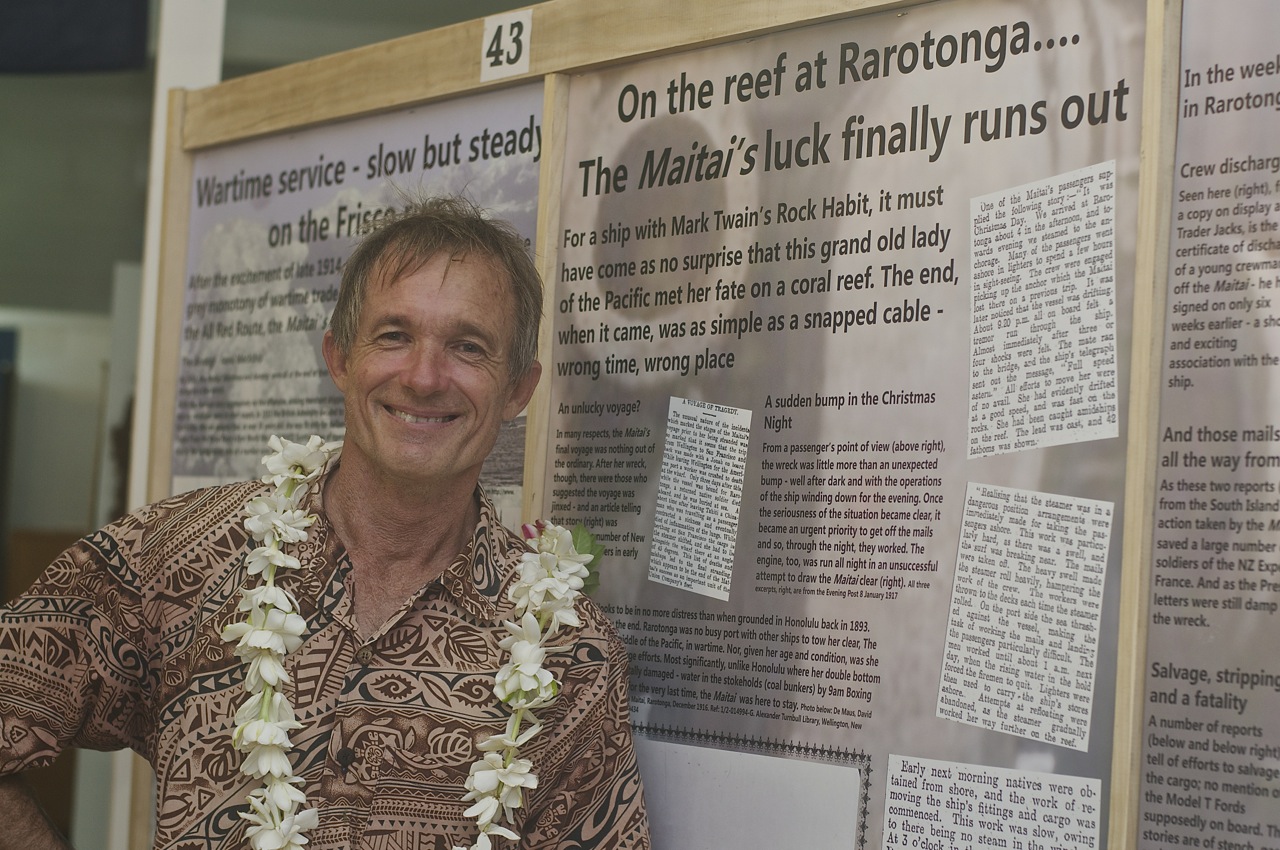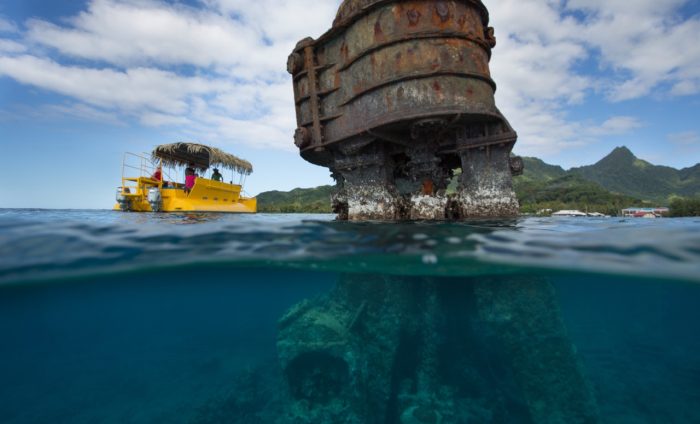The mysterious ‘boiler’
For Rarotonga, Christmas Day 2016 marked an unusual centenary - the day the Union Steam Ship Company’s RMS Maitai, was wrecked on the reef at Avarua.
Today, the ‘Boiler’ - as locals (incorrectly) refer to the ship’s main engine – is a bit of a mystery. However, as it looks set to be a fixture on the reef for another 100 years, the Cook Islands Sun decided to dig into the Maitai’s history. It turns out this lonely, forgotten, tower of rust marks the remains of a truly remarkable ship.
Thanks to Tim Arnold, Rarotonga resident, local steam enthusiast and internet trawler, here we can enjoy a fascinating insight into the ‘mysterious boiler’ and the wreck of the Maitai.
Beginnings – the Miowera
The Maitai did not start life either with that name or as a Union Steam Ship Company ship. She was built in Newcastle-on-Tyne back in 1892, as the Miowera, for James Huddart, a wealthy Australian shipowner.
Paying for her personally, the Miowera, along with her sister ship, Warrimoo, represented a good part of Huddart’s fortune. His great dream was for a British Empire shipping and railway route – the All Red Route – connecting Australia and New Zealand, across the Pacific, Canada and the Atlantic, to ‘Home’.
The Miowera’s arrival in Sydney in late 1892 marked the start of a fiercely contested trade war between Huddart’s company and the Union Steam Ship Company.
It was a price war like nothing seen before or since. Steamers like racehorses, galloping from port to port; newspapers keenly reporting speeds, times and tactics. Fares dropped to the point that a 10/- ($1.00) fare across the Tasman (with bed and board included) literally made it cheaper to travel than to stay home!
The madness could not last; in April 1893 a quiet gentlemen’s agreement saw the Miowera leave the ‘inter-colonial service’. Instead, she went off to make history – the very first voyage of the Pacific ‘All Red Route’ – a service that lasted for sixty years, carrying the royal mails between Australia and Vancouver.
The ‘Rock Habit’
Just months later, though, the Miowera was wrecked! High and dry on the Honolulu harbour reef. It took six weeks to salvage her; she was patched up and steamed round Cape Horn, all the way back to the UK so her builders could put a whole new bottom on the ship.
Huddart aimed to recover some of his losses by putting the Miowera on cruise work for the UK summer of 1894. A tour of the Norwegian fjords ended badly – it was ‘abandon ship’ when the pilot crashed open the ship’s side on a massive rock. Bruised and battered she limped back – a second time – to her builders.
By late 1894 the ship was notorious – the great Mark Twain referred to her jokingly as a ship ‘”with the Rock Habit”. Serious mechanical and boiler troubles followed, that saw Huddart suffer more losses. Famously, the Miowera helped rescue the steamship Strathnevis – adrift in the North Pacific for 59 days with over 200 aboard (its propeller had dropped off!). However, not even that salvage award could stave off bankruptcy. By late 1897, Huddart had lost both his fortune and his ships – by 1901 he was dead.
The Miowera continued her trans-Pacific runs, her line now under the control of the New Zealand Shipping Company. 1902 saw the Miowera make shameful legal history in Honolulu – some of that territory’s first-ever racial discrimination awards - after a black minstrel troupe were denied passage on the ship.
A performer who had less trouble getting aboard was Nellie Melba, the world famous Australian prima donna who today graces Australia’s $100 note. Her long-awaited homecoming was aboard the Miowera. Unfortunately, heavy weather led to delays, fuelling speculation the Miowera had sunk and taken Australia’s greatest daughter down with it!
Old and Slow
By 1908, ageing and slowing, the Miowera was taken off the All Red run. She was purchased by the Union Steam Ship Company, re-named the Maitai, and put back into service on the ‘inter-colonial’ run.
Two years later, though, the ship was again making history. Put on the ‘Frisco run, from Wellington to San Francisco, through Rarotonga and Papeete, she was one of the first New Zealand ships fitted with wireless. Famously, she brought back to Wellington with her, New Zealand’s first proper marine radio installation for the Government.
Veteran that she was, the Maitai lasted only two years on that run, but the start of WWI saw her replacement requisitioned as a troopship, so back she came!
Along with her running mate Moana, the Maitai avoided the cruisers Scharnhorst and Gneisnau that had shelled Papeete (our very own Tiare Taporo in harbour at the time) in September 1914, arriving to find the township battered and the coal heap still smoking!
The Maitai’s own fate, when it came on 25 December 1916, was almost an anticlimax – mid evening, a calm night with little breeze…and the sudden parting of the anchor chain, leaving her hard on a mushroom of coral that penetrated her hull - by 11am Boxing Day 1916 the fires were dropped for the last time.
Von Luckner and the ‘Auxiliary Cruiser’
The wrecked Maitai, though, had one more trick to play. In September 1917, several months abandoned, she lay in total darkness. A launch neared the Avarua harbour; aboard was Count Felix von Luckner, shipwrecked German raider and his crew of armed officers. They planned to come ashore to seize supplies and perhaps a larger boat; their own raider, the Seeadler, had been wrecked at Mopelia. Mistaking the darkness of the Maitai as a deliberate blackout by watchful crew, von Luckner instead opted to head back out to sea – the Maitai had saved Rarotonga from an armed landing!
By early 1920, it was all over; crashing storms had left just the engine (as today) and a small part of the bow visible. Picked over for non-ferrous scrap at the start of World War II, the Maitai played host to some enthusiastic amateur salvors in the 1950s and 60s. One of those, Gordon Keys, has recently published a short history of the ship, and a fascinating account of raising two of her propeller blades. A third blade helped finance Malcolm Sword Snr into Cook Islands General Transport.
 For more reading, visit the Maitai Exhibition at Cook Islands Library Museum on historic Makea Tinirau Road. And, to get up close and personal with this remarkable relic of those wonderful steamship days…. book a trip on the Raro Reef Sub, which sails out the wreck daily from Avatiu Harbour. Some of the local dive companies dive on the wreck.
For more reading, visit the Maitai Exhibition at Cook Islands Library Museum on historic Makea Tinirau Road. And, to get up close and personal with this remarkable relic of those wonderful steamship days…. book a trip on the Raro Reef Sub, which sails out the wreck daily from Avatiu Harbour. Some of the local dive companies dive on the wreck.
Tim Arnold
Image of Reef Sub and the Maitai wreck by Turama Photography.





